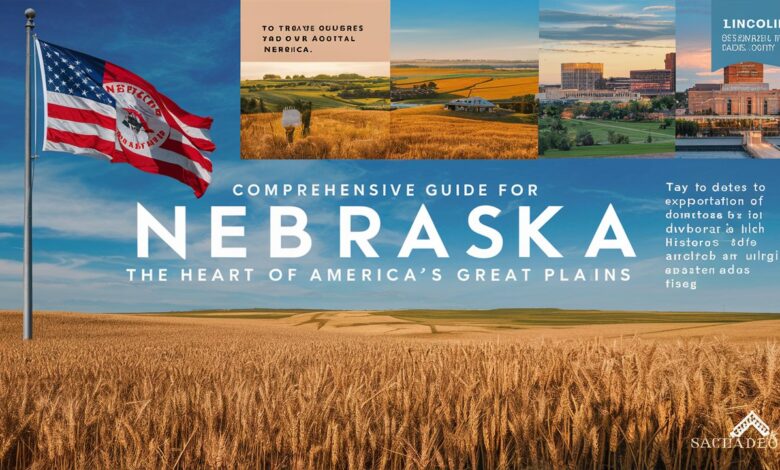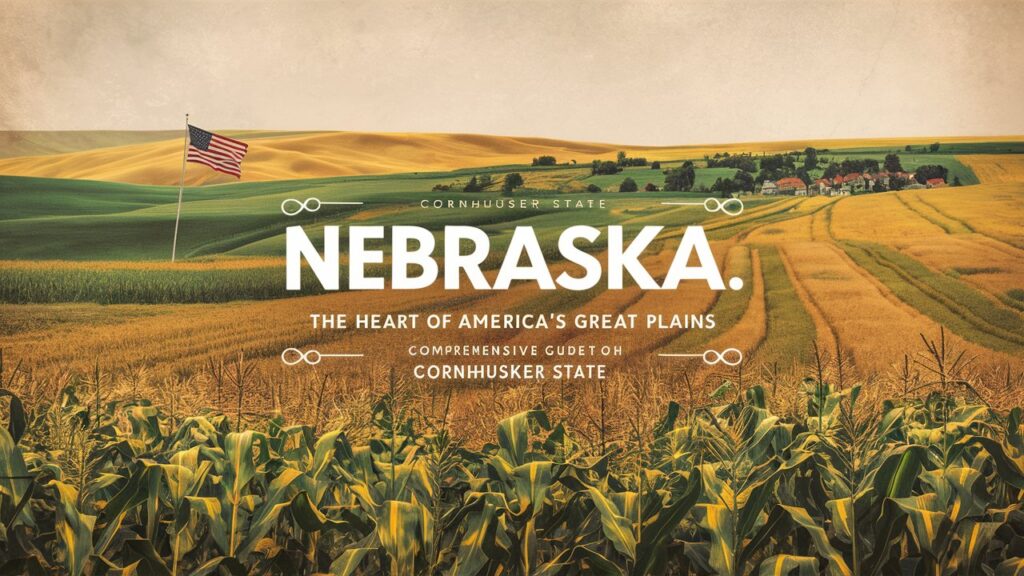Nebraska: The Heart of America’s Great Plains – A Comprehensive Guide to the Cornhusker State

Introduction
Nebraska, often referred to as the “Cornhusker State,” is a hidden gem nestled in the heart of the American Midwest. Known for its sprawling prairies, rich agricultural heritage, and friendly communities, Nebraska embodies the spirit of resilience and simplicity. While it may not boast the glitz of coastal states, its charm lies in its vast open spaces, historic trails, and unique natural wonders. From the iconic Sandhills to the mighty Missouri River, Nebraska offers a blend of history, culture, and outdoor adventure that appeals to travelers and residents alike. In this article, we’ll explore Nebraska’s geography, history, economy, cultural highlights, and more, providing a deep dive into what makes this state truly special.
Nebraska’s Geography and Climate: A Land of Contrasts
Nebraska’s geography is defined by its diverse landscapes, which range from rolling plains to dramatic rock formations. The state is part of the Great Plains region, characterized by fertile farmland that dominates the eastern third of the state. Moving westward, the terrain transitions into the Sandhills, a unique area of grass-covered sand dunes spanning over 19,000 square miles—the largest such formation in the Western Hemisphere. The Platte River, often called a “mile wide and an inch deep,” bisects the state, serving as a vital migratory corridor for sandhill cranes and other wildlife.
Nebraska’s climate is equally varied, with hot summers, cold winters, and occasional extreme weather. Tornadoes are a reality in the spring and summer, while blizzards can blanket the state in snow during winter. Despite these challenges, Nebraskans have adapted to their environment, building thriving communities that prioritize sustainability and connection to the land.
History and Heritage: Pioneers, Trails, and Native American Legacy
Long before European settlers arrived, Nebraska was home to Indigenous tribes like the Pawnee, Omaha, and Lakota Sioux. These communities thrived along the rivers, hunting bison and cultivating crops. The 19th century brought waves of pioneers traversing the Oregon, California, and Mormon Trails, many of whom passed through Nebraska’s Chimney Rock or Scotts Bluff—landmarks that symbolized hope and hardship on the journey west.
The Homestead Act of 1862 further shaped Nebraska’s identity, attracting settlers to claim free land and establish farms. This era birthed the state’s agricultural roots, which remain central to its economy today. Nebraska also played a role in the transcontinental railroad, with Omaha serving as a key hub. Museums like the Homestead National Historical Park and the Durham Museum in Omaha preserve this rich history, offering insights into the struggles and triumphs of Nebraska’s early inhabitants.
Economy and Agriculture: The Backbone of the Cornhusker State
Nebraska’s economy is deeply intertwined with agriculture. Ranked among the top U.S. states for corn, soybean, and beef production, it’s no surprise that farming and ranching dominate rural life. The state is a leader in irrigated farmland, thanks to the Ogallala Aquifer, a vast underground water source that sustains crops in arid regions.
Beyond agriculture, Nebraska has diversified its economy in recent decades. Omaha emerged as a financial center, hosting Fortune 500 companies like Union Pacific and Mutual of Omaha. Lincoln, the state capital, thrives on education and government sectors, anchored by the University of Nebraska. Additionally, Nebraska’s strategic location along Interstate 80 has made it a logistics and transportation powerhouse, connecting goods from coast to coast.
Natural Attractions and Outdoor Adventures
Nebraska’s natural beauty is often underrated, but those who explore its parks and trails are rewarded with unforgettable experiences. Chimney Rock National Historic Site and Scotts Bluff National Monument stand as towering reminders of the pioneer era, while Toadstool Geologic Park offers otherworldly rock formations reminiscent of the Badlands.
For outdoor enthusiasts, the Niobrara River provides opportunities for kayaking and tubing through scenic canyons, and the Sandhills Journey Scenic Byway invites road-trippers to witness untouched prairie landscapes. Wildlife lovers can visit the Crane Trust Nature & Visitor Center to observe the annual migration of half a million sandhill cranes—a spectacle dubbed “North America’s greatest bird migration.”

Cultural Highlights and Local Traditions
Nebraska’s culture is a blend of Midwestern hospitality, pioneer grit, and modern creativity. College football is a way of life, with the University of Nebraska’s Cornhuskers commanding fierce loyalty from fans. The state also celebrates its heritage through events like Nebraska State Fair, Old West Days in Chadron, and Czech Fest in Wilber, honoring the ethnic roots of early settlers.
The arts thrive here too. Omaha’s Joslyn Art Museum and Lincoln’s Sheldon Museum of Art showcase world-class collections, while the Carhenge installation in Alliance—a quirky replica of Stonehenge made from vintage cars—epitomizes Nebraska’s playful spirit. Don’t leave without trying local favorites like a juicy Omaha steak or a Runza (a savory pastry filled with beef and cabbage).
Conclusion: Embracing Nebraska’s Quiet Majesty
Nebraska may not shout for attention, but its understated beauty and enduring values leave a lasting impression. Whether you’re driving through golden cornfields, exploring fossil beds at Agate Fossil Beds National Monument, or chatting with locals at a county fair, the state offers a refreshing escape from the hustle of modern life. As environmentalist John Muir once said, “The plains of Nebraska are beautifully skirted with rose-tinted horizons,” a testament to the state’s serene and timeless appeal. For those willing to venture off the beaten path, Nebraska is a destination that rewards curiosity and connection.
Frequently Asked Questions (FAQs)
1. What is the best time to visit Nebraska?
Spring (April–May) and fall (September–October) are ideal for mild weather and outdoor activities. Spring also brings the iconic sandhill crane migration, while fall showcases vibrant foliage.
2. Why is Nebraska called the Cornhusker State?
The nickname honors the state’s agricultural roots and the manual laborers who husked corn by hand before mechanization. It was officially adopted in 1945.
3. What are Nebraska’s top tourist attractions?
Must-see sites include Chimney Rock, Henry Doorly Zoo (ranked among the world’s best), Scotts Bluff National Monument, and the Sandhills.
4. Is Nebraska culturally diverse?
Yes! While predominantly rural, cities like Omaha and Lincoln have growing multicultural communities, influenced by Latino, African American, and European immigrant populations.
5. What foods is Nebraska known for?
Beyond corn and beef, try a Runza, Kool-Aid (invented in Hastings), and Omaha’s steakhouses. The state also produces award-winning wines and craft beers.
6. How does Nebraska’s economy stay resilient?
By balancing agriculture with sectors like finance, insurance, and tech. Innovations in biofuels and sustainable farming also drive growth.
Whether you’re planning a visit or simply curious, Nebraska’s story is one of perseverance, community, and natural wonder—a true reflection of America’s heartland. 🌾



